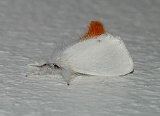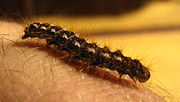
Brown-tail
Encyclopedia
The brown-tail is a moth
of the family Lymantriidae
. It is distributed throughout Europe
.
The wings of this species are pure white, as is the body, apart from a tuft of brown hairs at the end of the abdomen
. The brown coloration extends along most of the back of the abdomen in the male. In the female, the back of the abdomen is white, but the tuft of brown hairs is much bigger. The wingspan
is 36-42 mm. The species flies at night in July and August and is attracted to light.
The larva
is brown with red and white markings and is very hairy. These hairs provide protection for this species throughout its life cycle: the larva incorporates some into the cocoon within which it pupa
tes; the emerging adult female collects some on its tail and uses it to camouflage
and protect the eggs
as they are laid. The species overwinters communally as larvae within a tough, silken tent. In areas where the species is abundant, these tents are a familiar sight, and can be seen on a huge range of plants (see list below).
The hairs break off as barbs and on contact with skin can cause rashes, skin irritation, headaches and breathing difficulties. The species should be handled using protective gloves at all stages of its life cycle. After accidental contact, people should wash their hands in soapy water and clear their eyes using an eyewash. Within London, local authorities can require householders to destroy any moths found on their property, under Section 8 of the Greater London Council (General Powers) Act 1979.


Moth
A moth is an insect closely related to the butterfly, both being of the order Lepidoptera. Moths form the majority of this order; there are thought to be 150,000 to 250,000 different species of moth , with thousands of species yet to be described...
of the family Lymantriidae
Lymantriidae
Lymantriidae is a family of moths. Many of its component species are referred to as "Tussock moths" of one sort or another. The caterpillar, or larval, stage of these species often has a distinctive appearance of alternating bristles and haired projections...
. It is distributed throughout Europe
Europe
Europe is, by convention, one of the world's seven continents. Comprising the westernmost peninsula of Eurasia, Europe is generally 'divided' from Asia to its east by the watershed divides of the Ural and Caucasus Mountains, the Ural River, the Caspian and Black Seas, and the waterways connecting...
.
The wings of this species are pure white, as is the body, apart from a tuft of brown hairs at the end of the abdomen
Abdomen
In vertebrates such as mammals the abdomen constitutes the part of the body between the thorax and pelvis. The region enclosed by the abdomen is termed the abdominal cavity...
. The brown coloration extends along most of the back of the abdomen in the male. In the female, the back of the abdomen is white, but the tuft of brown hairs is much bigger. The wingspan
Wingspan
The wingspan of an airplane or a bird, is the distance from one wingtip to the other wingtip. For example, the Boeing 777 has a wingspan of about ; and a Wandering Albatross caught in 1965 had a wingspan of , the official record for a living bird.The term wingspan, more technically extent, is...
is 36-42 mm. The species flies at night in July and August and is attracted to light.
The larva
Larva
A larva is a distinct juvenile form many animals undergo before metamorphosis into adults. Animals with indirect development such as insects, amphibians, or cnidarians typically have a larval phase of their life cycle...
is brown with red and white markings and is very hairy. These hairs provide protection for this species throughout its life cycle: the larva incorporates some into the cocoon within which it pupa
Pupa
A pupa is the life stage of some insects undergoing transformation. The pupal stage is found only in holometabolous insects, those that undergo a complete metamorphosis, going through four life stages; embryo, larva, pupa and imago...
tes; the emerging adult female collects some on its tail and uses it to camouflage
Camouflage
Camouflage is a method of concealment that allows an otherwise visible animal, military vehicle, or other object to remain unnoticed, by blending with its environment. Examples include a leopard's spotted coat, the battledress of a modern soldier and a leaf-mimic butterfly...
and protect the eggs
Egg (biology)
An egg is an organic vessel in which an embryo first begins to develop. In most birds, reptiles, insects, molluscs, fish, and monotremes, an egg is the zygote, resulting from fertilization of the ovum, which is expelled from the body and permitted to develop outside the body until the developing...
as they are laid. The species overwinters communally as larvae within a tough, silken tent. In areas where the species is abundant, these tents are a familiar sight, and can be seen on a huge range of plants (see list below).
The hairs break off as barbs and on contact with skin can cause rashes, skin irritation, headaches and breathing difficulties. The species should be handled using protective gloves at all stages of its life cycle. After accidental contact, people should wash their hands in soapy water and clear their eyes using an eyewash. Within London, local authorities can require householders to destroy any moths found on their property, under Section 8 of the Greater London Council (General Powers) Act 1979.


- The flight season refers to the British IslesBritish IslesThe British Isles are a group of islands off the northwest coast of continental Europe that include the islands of Great Britain and Ireland and over six thousand smaller isles. There are two sovereign states located on the islands: the United Kingdom of Great Britain and Northern Ireland and...
. This may vary in other parts of the range.
Recorded food plants
- AcaciaAcaciaAcacia is a genus of shrubs and trees belonging to the subfamily Mimosoideae of the family Fabaceae, first described in Africa by the Swedish botanist Carl Linnaeus in 1773. Many non-Australian species tend to be thorny, whereas the majority of Australian acacias are not...
- Acer - MapleMapleAcer is a genus of trees or shrubs commonly known as maple.Maples are variously classified in a family of their own, the Aceraceae, or together with the Hippocastanaceae included in the family Sapindaceae. Modern classifications, including the Angiosperm Phylogeny Group system, favour inclusion in...
- Amelanchier
- Arctium - BurdockBurdockBurdock is any of a group of biennial thistles in the genus Arctium, family Asteraceae. Native to the Old World, several species have been widely introduced worldwide....
- Betula - BirchBirchBirch is a tree or shrub of the genus Betula , in the family Betulaceae, closely related to the beech/oak family, Fagaceae. The Betula genus contains 30–60 known taxa...
- Carya - HickoryHickoryTrees in the genus Carya are commonly known as hickory, derived from the Powhatan language of Virginia. The genus includes 17–19 species of deciduous trees with pinnately compound leaves and big nuts...
- CastaneaCastaneaCastanea can mean:* Castanea , a plant genus including the chestnuts and chinkapins* Castanea, Pennsylvania, a census-designated place * Castanea Township, Pennsylvania, which surrounds the CDP of the same name...
- Chestnut - ChaenomelesChaenomelesChaenomeles is a genus of three species of deciduous spiny shrubs, usually 1–3 m tall, in the family Rosaceae. They are native to eastern Asia in Japan, China and Korea...
- Flowering quince ('Japonica') - CrataegusCrataegusCrataegus , commonly called hawthorn or thornapple, is a large genus of shrubs and trees in the rose family, Rosaceae, native to temperate regions of the Northern Hemisphere in Europe, Asia and North America. The name hawthorn was originally applied to the species native to northern Europe,...
- Hawthorn - Cydonia - QuinceQuinceThe quince , or Cydonia oblonga, is the sole member of the genus Cydonia and native to warm-temperate southwest Asia in the Caucasus region...
- Fagus - BeechBeechBeech is a genus of ten species of deciduous trees in the family Fagaceae, native to temperate Europe, Asia and North America.-Habit:...
- ForsythiaForsythiaForsythia is a genus of flowering plants in the family Oleaceae . There are about 11 species, mostly native to eastern Asia, but one native to southeastern Europe. The common name is also Forsythia; the genus is named after William Forsyth.-Growth:They are deciduous shrubs typically growing to a...
- Fragaria - StrawberryStrawberryFragaria is a genus of flowering plants in the rose family, Rosaceae, commonly known as strawberries for their edible fruits. Although it is commonly thought that strawberries get their name from straw being used as a mulch in cultivating the plants, the etymology of the word is uncertain. There...
- Fraxinus - Ash
- Geranium - CranesbillCranesbillGeranium is a genus of 422 species of flowering annual, biennial, and perennial plants that are commonly known as the cranesbills. It is found throughout the temperate regions of the world and the mountains of the tropics, but mostly in the eastern part of the Mediterranean region. The long,...
- Gossypium - Cotton plant
- Hippophae - Sea-buckthornSea-buckthornThe sea-buckthorns are deciduous shrubs in the genus Hippophae, family Elaeagnaceae. The name sea-buckthorn is hyphenated here to avoid confusion with the buckthorns...
- Juglans - WalnutWalnutJuglans is a plant genus of the family Juglandaceae, the seeds of which are known as walnuts. They are deciduous trees, 10–40 meters tall , with pinnate leaves 200–900 millimetres long , with 5–25 leaflets; the shoots have chambered pith, a character shared with the wingnuts , but not the hickories...
- Malus - AppleAppleThe apple is the pomaceous fruit of the apple tree, species Malus domestica in the rose family . It is one of the most widely cultivated tree fruits, and the most widely known of the many members of genus Malus that are used by humans. Apple grow on small, deciduous trees that blossom in the spring...
- MyricaMyricaMyrica is a genus of about 35–50 species of small trees and shrubs in the family Myricaceae, order Fagales. The genus has a wide distribution, including Africa, Asia, Europe, North America and South America, and missing only from Australasia...
- Parthenocissus - Virginia creeper
- PlantagoPlantagoPlantago is a genus of about 200 species of small, inconspicuous plants commonly called plantains. They share this name with the very dissimilar plantain, a kind of banana. Most are herbaceous plants, though a few are subshrubs growing to 60 cm tall. The leaves are sessile, but have a narrow...
- Plantain - Populus - PoplarPoplarPopulus is a genus of 25–35 species of deciduous flowering plants in the family Salicaceae, native to most of the Northern Hemisphere. English names variously applied to different species include poplar , aspen, and cottonwood....
- PrunusPrunusPrunus is a genus of trees and shrubs, which includes the plums, cherries, peaches, apricots and almonds. There are around 430 species spread throughout the northern temperate regions of the globe. Many members of the genus are widely cultivated for fruit and ornament.-Botany:Members of the genus...
- Pyrus - PearPearThe pear is any of several tree species of genus Pyrus and also the name of the pomaceous fruit of these trees. Several species of pear are valued by humans for their edible fruit, but the fruit of other species is small, hard, and astringent....
- Quercus - OakOakAn oak is a tree or shrub in the genus Quercus , of which about 600 species exist. "Oak" may also appear in the names of species in related genera, notably Lithocarpus...
- Rheum - RhubarbRhubarbRhubarb is a group of plants that belong to the genus Rheum in the family Polygonaceae. They are herbaceous perennial plants growing from short, thick rhizomes. They have large leaves that are somewhat triangular-shaped with long fleshy petioles...
- RibesRibesRibes is a genus of about 150 species of flowering plants native throughout the temperate regions of the Northern Hemisphere. It is usually treated as the only genus in the family Grossulariaceae. Seven subgenera are recognized....
- Currant - RobiniaRobiniaRobinia is a genus of flowering plants in the family Fabaceae, subfamily Faboideae, native to North America and northern Mexico. Commonly known as "locusts", they are deciduous trees and shrubs growing 4-25 m tall. The leaves are pinnate with 7-21 oval leaflets. The flowers are white or pink, in...
- Rosa - RoseRoseA rose is a woody perennial of the genus Rosa, within the family Rosaceae. There are over 100 species. They form a group of erect shrubs, and climbing or trailing plants, with stems that are often armed with sharp prickles. Flowers are large and showy, in colours ranging from white through yellows...
- RubusRubusRubus is a large genus of flowering plants in the rose family, Rosaceae, subfamily Rosoideae. Raspberries, blackberries, and dewberries are common, widely distributed members of the genus. Most of these plants have woody stems with prickles like roses; spines, bristles, and gland-tipped hairs are...
- RumexRumexThe docks and sorrels, genus Rumex L., are a genus of about 200 species of annual, biennial and perennial herbs in the buckwheat family Polygonaceae....
- Dock - Salix - WillowWillowWillows, sallows, and osiers form the genus Salix, around 400 species of deciduous trees and shrubs, found primarily on moist soils in cold and temperate regions of the Northern Hemisphere...
- Sambucus - ElderberryElderberrySambucus is a genus of between 5 and 30 species of shrubs or small trees in the moschatel family, Adoxaceae. It was formerly placed in the honeysuckle family, Caprifoliaceae, but was reclassified due to genetic evidence...
- SorbusSorbusSorbus is a genus of about 100–200 species of trees and shrubs in the subfamily Maloideae of the Rose family Rosaceae. Species of Sorbus are commonly known as whitebeam, rowan, service tree, and mountain ash...
- SpiraeaSpiraeaSpiraea , is a genus of about 80-100 species of shrubs in the family Rosaceae, subfamily Spiraeoideae. They are native to the temperate Northern Hemisphere, with the greatest diversity in eastern Asia....
- TiliaTiliaTilia is a genus of about 30 species of trees native throughout most of the temperate Northern Hemisphere. The greatest species diversity is found in Asia, and the genus also occurs in Europe and eastern North America, but not western North America...
- Lime - Trifolium - CloverCloverClover , or trefoil, is a genus of about 300 species of plants in the leguminous pea family Fabaceae. The genus has a cosmopolitan distribution; the highest diversity is found in the temperate Northern Hemisphere, but many species also occur in South America and Africa, including at high altitudes...
- Ulmus - ElmElmElms are deciduous and semi-deciduous trees comprising the genus Ulmus in the plant family Ulmaceae. The dozens of species are found in temperate and tropical-montane regions of North America and Eurasia, ranging southward into Indonesia. Elms are components of many kinds of natural forests...
- ViburnumViburnumViburnum is a genus of about 150–175 species of shrubs or small trees in the moschatel family, Adoxaceae. Its current classification is based on molecular phylogeny...
- Vitis - GrapeGrapeA grape is a non-climacteric fruit, specifically a berry, that grows on the perennial and deciduous woody vines of the genus Vitis. Grapes can be eaten raw or they can be used for making jam, juice, jelly, vinegar, wine, grape seed extracts, raisins, molasses and grape seed oil. Grapes are also...
- WeigelaWeigelaWeigela is a small genus of about 12 species of deciduous shrubs in the family Caprifoliaceae, growing to 1-5 m tall. All are natives of eastern Asia. The genus is named after the German scientist Christian Ehrenfried Weigel....
- WisteriaWisteriaWisteria is a genus of flowering plants in the pea family, Fabaceae, that includes ten species of woody climbing vines native to the eastern United States and to China, Korea, and Japan. Aquarists refer to the species Hygrophila difformis, in the family Acanthaceae, as Water Wisteria...

